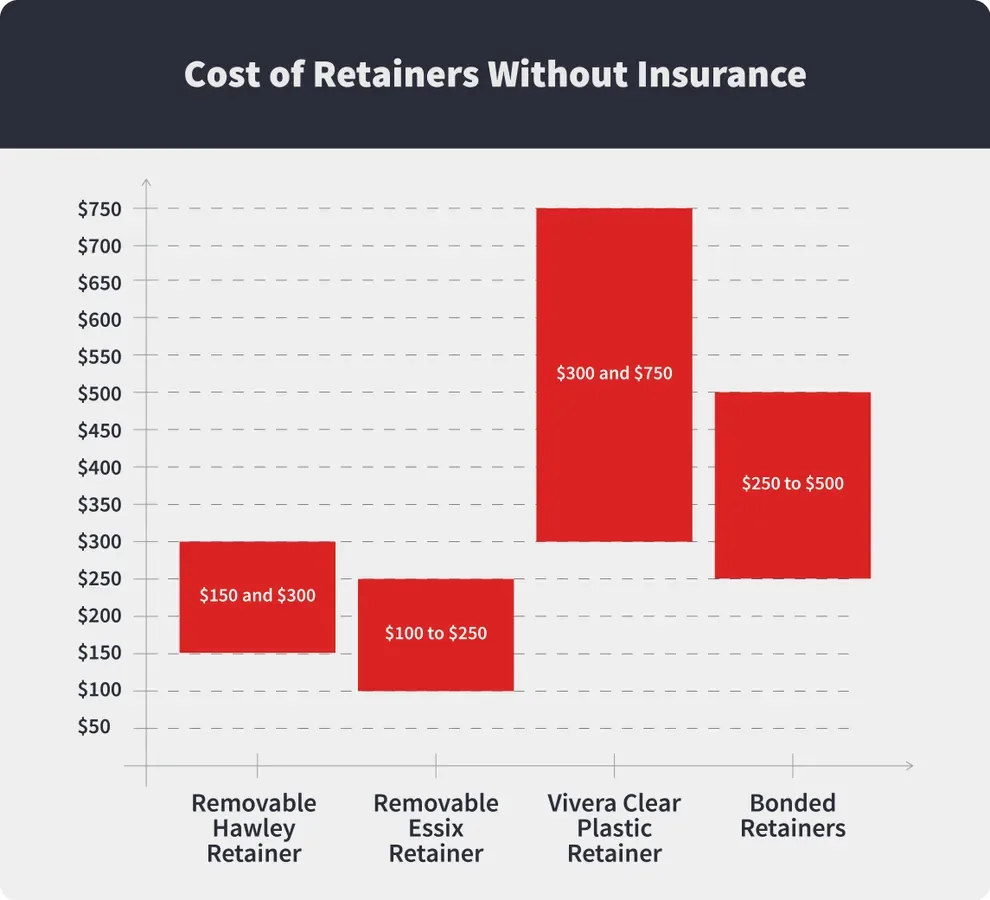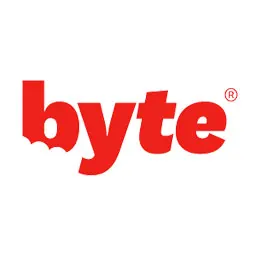How Much Do Retainers Cost With & Without Insurance?

Table of Contents
- Quick Facts
- Cost Without Insurance
- Retainers Might be Partially Covered
- Why Pay for a Retainer?
- Factors that Affect the Cost of Retainers
- At-Home Aligner Treatment
- Pros & Cons of Retainer Types
- How to Navigate Insurance
- Are Retainers Worth the Cost?
- Retainer Cost FAQs
Retainers vary in cost depending on the type of retainer you get, ranging from $300 to $5,000. Like braces or aligners, retainers might be partially covered by your dental insurance.
Quick Facts about the Cost of Retainers
Without dental insurance, retainers can cost around $300, with the most expensive options costing around $5,000.
If you have coverage for orthodontic treatment, the cost of your retainer may be fully or partially covered by insurance.
Factors that affect the cost of retainers include the provider you choose for aligners, the durability of your retainer, and how much it will cost to replace.
Many at-home clear aligner providers offer retainers after treatment. Some (including Byte) will provide you with your first retainer for free and offer hassle-free protection plans for fast and affordable retainer replacement.

The Cost of Retainers Without Dental Insurance
When you first look at the cost of a retainer, you may see the upfront cost, which does not include any coverage provided by your dental insurance. The cost can vary depending on what type of retainer is recommended. The lowest cost is around $300, while the highest cost is as much as $5,000.
Check with your orthodontist for a discount at times of $50 to $150 off the total for ordering two sets of retainers at once. You’ll then have a backup set.
Here is the cost breakdown for different types of retainers:
This is the stereotypical retainer, made from formed plastic and metal wires. The average cost for one Hawley retainer is between $150 and $300, with a set costing up to $600.
When you or your child has braces, a Hawley retainer is often covered in the overall upfront treatment cost. If you lose or break the retainer, a replacement may need to be paid for entirely out of pocket, and this usually costs between $70 and $500.
This type of retainer is made exclusively of formed acrylic. It is actually less expensive than the Hawley retainer, ranging from $100 to $250 for one or $200 to $500 for a set.
Essix retainers are more likely to warp or break than Hawley retainers, so you may find yourself spending $100 to $200 to replace them once or twice during treatment.
This is a type of clear plastic aligner that is part of treatment with Invisalign. Typically, you receive a new set of aligners every three months, with an annual fee of between $300 and $750.
Occasionally, your dentist may recommend a “permanent” retainer or a bonded retainer, which is applied to the back of your teeth to reduce how much they shift over time. These range in price from $250 to $500 for one arch and $500 to $1,000 for both arches.
You are most likely to have one bonded retainer, applied to the bottom teeth, with a removable retainer prescribed for the top.
Pros & Cons of Retainer Types
What type of retainer should you use to keep your teeth in place? Your dentist can help you decide, but a few pros and cons apply to most people.
Fixed retainers offer around-the-clock protection for your teeth, as they can’t be removed. You won’t forget to put them in, as you can never take them out. You also won’t need to worry about losing your trays, as they’ll always be in place.
Removable retainers require some discipline. You must be careful to follow your treatment plan and keep your trays on your teeth for enough hours per day. However, they can be removed for a thorough cleaning. Fixed retainers don’t allow you to floss easily, which can lead to tooth decay. Removable retainers give you more flexibility.
No matter what type of retainer you choose, it’s a smart investment. Keeping your teeth in place can mean avoiding costs associated with another round of treatment.
Retainers Might Be Partially Covered by your Dental Insurance
Some dental insurance plans cover up to half the cost of your overall orthodontics treatment, which should include the cost of retainers. However, not all of them do so.
Basic dental insurance plans may treat your adulthood orthodontics treatment as a cosmetic (rather than a medical) procedure. If so, you may struggle to get the right amount of financial coverage for your needs.
Some dental insurance plans allow you to add a health savings plan or a discount plan, which can help lower the cost of orthodontics treatment when you use in-network, well-respected orthodontists.
Additionally, some dental insurance companies offer specific coverage for braces and retainers, called orthodontic insurance. These plans can support the cost of braces, aligners, retainers, and other orthodontic devices that might be needed.
How to Navigate Insurance for Retainers
Insurance coverage can help you save money on retainers, but you must do your homework and confirm your benefits.
Ask your insurance provider the following questions to get started:
Does my plan cover orthodontic care? If it doesn’t, do you have a discount program?
Do I have to choose a provider from your network to use my benefits, or can I go anywhere?
Do I have a yearly limit on how much you’ll pay? Have I reached that limit yet?
After this conversation, you should have a good idea of how much your plan might pay for retainers. Next, tell your dental provider that you’d like to use your benefits to cover your bill. Determine if your dentist will work directly with your insurance company or if you’re required to pay the doctor and submit the bill to insurance for reimbursement.
If your plan doesn’t cover orthodontics care (and many do not), ask about adding that coverage to your plan. For a few dollars a month, you could get the care you need to perfect your smile. Some dental plans require a waiting period, in which you pay premiums but get no covered care, but not all of them do. Explore your options, and you’ll make a wise choice for your budget.
Why Should I Pay for a Retainer?
If you had braces as a child, you may be familiar with retainers. These are typically metal and plastic devices that fit around your teeth to keep them from shifting after braces have been removed or treatment with other orthodontic treatment like clear aligners has been completed.
Children and teenagers who need retainers may wear them for a few months and then no longer need them. However, it is common for teeth to shift over your life. You may find that, as an adult, you return to orthodontic treatment with clear teeth aligners or braces and then need a retainer.
You may consider opting out of getting a retainer if you pursue orthodontics treatment simply because of the added cost. Rather than paying for an expensive device, you may decide to quit once your teeth have been aligned.
Retainers are important for keeping your teeth aligned, so you do not need to pursue another round of orthodontics treatment later in life. Even if a retainer appears costly upfront, it can save you money in the long run.
Factors that Affect the Cost of Retainers
When beginning orthodontic treatment, your retainer (and especially the cost of your retainer) may be the last thing on your mind. However, retainers are a necessity after any type of orthodontic treatment, and their cost is something you should consider before even beginning your braces or aligner treatment.
Factors that affect the cost of retainers may include the following:
Your retainer provider: Many individuals will get their retainers from the same provider they received treatment from, often an orthodontist or clear aligner provider. While many at-home clear aligner providers tend to be straightforward about their retainer pricing, in-office providers may not provide you with many options unless you ask.Whether you’re going with clear aligners or traditional braces, be sure that you have a full understanding of your retainer options and what your retainer will cost.
Fixed or removable: Fixed retainers, installed by an orthodontist, may be more costly than your average removable retainer. However, insurance may cover some of the costs, depending on your plan.
Durability and replacement: How easily your retainer is damaged or broken — and how much it will cost to replace — should also be considered when weighing the costs of different retainers. For example, acrylic Essix retainers are generally easier to damage than Hawley retainers, and they are often more costly to replace.
Retainer protection plans: Some retainer and/or clear aligner providers, including Byte, offer affordable protection plans to ensure that a new retainer will be sent to you fast, without a huge surprise cost, if you lose or damage your existing retainer.
Insurance coverage: Check with your insurance provider regarding how much your out-of-pocket costs will be on your retainer and also how much a replacement will cost.
At-Home Aligner Treatment May Give You a Free Retainer
Although your dental insurance may cover some cost of your orthodontics treatment, including retainers, you may find that standard treatment is too expensive. Fortunately, there are several companies that now offer at-home, over-the-counter orthodontics treatment with customized clear plastic aligners.
These aligners may not be covered by your insurance, but an aligner treatment plan often costs less than most braces or traditional aligners. At Byte, for example, we offer all-day aligner treatment plans for a one-time payment of $1,999. On average, braces cost between $5,000 and $6,000, making aligners a smart and cost-saving choice.
Many aligner companies, including Byte, offer retainers at the end of treatment for no cost. That means you won’t face an unexpected bill at the end of care. Very few traditional dental offices do the same after providing braces. You can expect a bill of a few hundred extra dollars at the end of a program like this.
Are Retainers Worth the Cost?
The average retainer costs just a few hundred dollars, and most of them are durable devices that last for years with proper care. The expenses associated with skipping retainers are often higher than those linked to buying one and wearing it properly.
If you don’t wear a retainer, your teeth are likely to shift back into their former positions. If they do, you’ll need another round of orthodontic care to bring them back into alignment.
According to Consumer Affairs, the average cost of braces ranges from $5,000 to $6,000. Aligners are much less expensive, but they can cost $1,000 to $3,000. At the end of this second round of treatment, you’ll also need retainers.
Different types of retainers come with a different price tag, as follows:
Hawley retainers: These devices cost between $150 and $300. They’re typically made of plastic and metal, and they can last for years.
Clear plastic retainers: These trays cost between $100 and $250, and they’re made of medical-grade plastic. With proper care, they can last for years.
Bonded retainers: These devices consist of wire attached to your teeth. They cost $250 to $500 and can last indefinitely.
Given the low cost and durability of retainers, and the fact that you’ll need them after any orthodontic procedure, they make a good investment.
Retainer Cost Frequently Asked Questions
The best type of retainer depends on your preferences. Each type has its own set of pros and cons. The most important considerations that influence your choice of retainer include effectiveness, maintenance, durability, convenience, and appearance.
Overall, customer reviews give the edge to permanent retainers and clear, plastic aligner retainers.
The replacement cost of your retainer depends on the type of retainer you chose to begin with, but these are the average costs of replacing different types of retainers:
Hawley retainers: $150–$300
Clear plastic retainers: $100–$250
Permanent retainers: $250–$500
